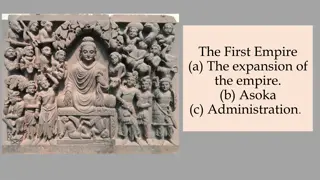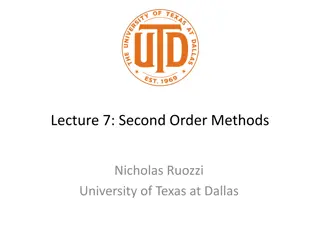Social Order and Administrative Structure in Mauryan Age
The Mauryan Age saw political unification, thriving trade, organized crafts, and a complex social structure in India. The Mauryan Empire's extent, aims of human life, and administrative divisions based on population size influenced urban development under Kautilya's Arthashastra.
Download Presentation

Please find below an Image/Link to download the presentation.
The content on the website is provided AS IS for your information and personal use only. It may not be sold, licensed, or shared on other websites without obtaining consent from the author.If you encounter any issues during the download, it is possible that the publisher has removed the file from their server.
You are allowed to download the files provided on this website for personal or commercial use, subject to the condition that they are used lawfully. All files are the property of their respective owners.
The content on the website is provided AS IS for your information and personal use only. It may not be sold, licensed, or shared on other websites without obtaining consent from the author.
E N D
Presentation Transcript
Subject: Principles Of Human Settlements-I Topic: Mauryan Age Presented by: Fazlur Rahman
SOCIAL ORDER DURING SOCIAL ORDER DURING MAURYAN MAURYAN AGE AGE POLITICAL UNIFICATION OF INDIA BOOST TO TRADE AND VARIOUS CRAFTS ARTISANS WERE ORGANIZED IN CORPORATE BODIES OR GUILDS CRAFTS BECAME SMALL-SCALE INDUSTRIES THE TRADING NETWORKS, BOTH LAND AND MARINE SPANNED THE WHOLE INDIAN SUBCONTINENT, MESOPOTAMIA, IRAN AND THE WEST ASIA TRADE WAS DILIGENTLY SUPERVISED BY THE STATE MONETARIZATION - SILVER AND COPPER COINS WERE BEING USED APART FROM COMMERCE, THERE WERE VARIED ECONOMIES LIKE AGRICULTURE, NOMADIC PASTORALISM AND HUNTING GATHERING TAKEN CARE BY THE GOVERNMENT BUILT AND MAINTAINED A NETWORK OF ROADS ALL OVER THE COUNTRY PROVIDED PUBLIC IRRIGATION FACILITIES SOCIAL STRUCTURE WAS MULTI- LAYERED AND COMPLEX
MAURYAN MAURYAN EMPIRE EMPIRE E E X X T T E E N N T T
AIMS OF HUMAN LIFE MOKSHA DHARMA ARTHA KARMA All these fundamentals are relative and hold relevance at various stages of ones life. The concept based on these fundamentals acted as refrences for design and development of the ancient Indian cities. While there are numerous treatises such as Manusmruti, Shukra Niti, Vaastu Shastra, etc. which dictate the forms of shelters and towns. Kautilya s Arthashastra is considered to be a comprehensive treaty and addresses those entire essential fundamentals specific to the practices of design and development of human settlements.
KAUTILYAS ARTHASHASTRA Well defined hierarchy of the urban centers and the administrative divisions. These divisions were based mainly on the - size of population and - were influenced by the resources available in the region and - opportunities for economic development.
ADMINISTRATIVE DIVISIONS BASED ON THE SIZE OF POPULATION The smallest division was a village consisting of each not less than a hundred families and not more than five hundred families of agricultural people with boundaries extending as far as a kr sa (2,250 yards). Further, in his policies on urbanization, Kautilya encourages migration to the countryside in order to prevent overcrowding into the cities. This ensured a control over population as well as building densities. From the perspective of managing the divisions, Kautilya adopted clustered approach with each cluster comprising of certain number of villages. A cluster of around eight hundred villages was to be centered by a sth n ya a (a fortress of that name), four hundred villages by a dr namukha, two hundred villages by a kh rv tika and sangrahana in the midst of a collection of ten villages. Boundaries of settlements were to be denoted either by a river, a mountain, forests, bulbous plants (grishti), caves, artificial buildings (s tubandha), or by trees such as s lmali (silk cotton tree), sam (Acacia Suma), and ksh ravriksha (milky trees).
INTRODUCTION TO THE GUPTA PERIOD http://upload.wikimedia.org/wikipedia/commons/thumb/4/4c/Nalanda_University_India_ruins.jpg/250px-Nalanda_University_India_ruins.jpg In the fourth century, the Gupta Empire was established. The Gupta dynasty lasted from circa 320 - circa 540 B BCE. In the Gupta Age, the Hindu religion strengthened. The Ajanta and Ellora caves were created in this period. Many classical art forms and aspects of Indian culture were further developed. During the Gupta Age much progress was made in literature, science, and especially astronomy and mathematics. Due to many new ideas, and breakthroughs in Indian civilization, historians have called Gupta India, "The Golden Age of Indian History".
GUPTA RULERS PROMOTED HINDUISM IN THEIR EMPIRE. A New Hindu Empire The Gupta dynasty took over India around AD 320. Under the Guptas, India was again united and it prospered. Hinduism became India s dominant religion. However, the Gupta rulers also supported the religious beliefs of Buddhism and Jainism. Gupta Society Gupta society reached its high point around 375, during the rule of Candra Gupta II. The empire had a strong economy, its people prospered, and fine works of art and literature were created. The Gupta kings believed in the strict social order of the Hindu caste system and women s roles were limited.
THE GOLDEN AGE OF INDIA The Gupta Period was usually described as the "golden age of India" as it was a period of great military power and wealth and there was also great development in the arts and sciences. SOME SIGNIFICANT FEATURES OF GUPTA PERIOD NALANDA UNIVERSITY . Cultural Resources of NALANDA Nalanda is primarily a archaeological site exposed during the excavations conducted by Archaeological Survey of India during 1915-37 and 1974-82. There are references that the city was spread over an area of sixteen square kilometers of which only an area of around square kilometer is excavated.
The extensive remains are of six brick temples and eleven monasteries arranged on a systematic layout. The campus has rows of magnificent stupas placed side by side forming a central monumental axis. Parallel to and on both sides of this axis were monasteries along with establishments for housing students aspiring to become monks. The dimension and disposition of rooms within monasteries is almost identical. The most imposing structure is Temple No. 3 at the southern extremity which was constructed in seven phases. This follows the pancharatna concept of planning consisting of a central shrine and four subsidiary ones in the corner.
File:Nalanda layout 1b.JPG The monasteries were imposing rectangular building These monasteries or Viharas were planned around a central open court. These functioned both as units of residence as well as learning. The lower storey contained the refectory, areas of instructions and communal worship, while the upper floor built in timber was quadrangle of cells for resident students. Each subsequent higher storey was stepped back from the previous one to create open air terraces for the cells. These were used by more preserving students who had graduated to an advanced stage of learning.
REFFERENCES REFFERENCES Human settlements by Chatopadhyaya. Indian architecture by Percy Brown Buddhist and Hindu Architecture by Satish Grover http://india.gov.in/knowindia/ancient_history5.php www.wikepediaencyclopedia.com























